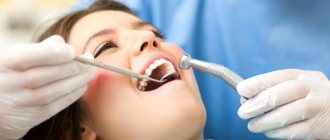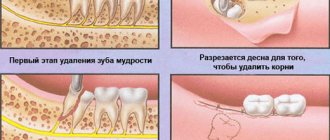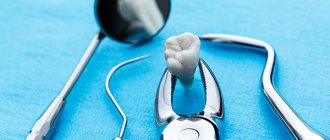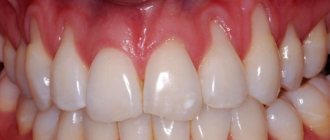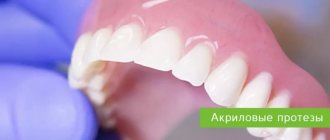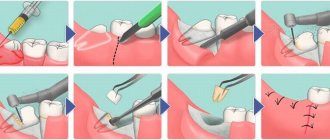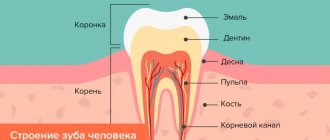Tooth extraction in dentistry is divided into simple and complex. When extracting a tooth with one root, such manipulation is considered simple. If the tooth has a complex root with several branches, then the procedure for removing it will be complex and is carried out using special tools and techniques.
In what cases is dental surgery difficult?
Complex manipulations regarding tooth extraction include the following situations:
- with disconnected roots that are excessively curved inward or directed in different directions;
- when the problem tooth is located in the affected bone;
- in the complete absence of a crown, when there is nothing to grab onto with forceps;
- if a filling was previously installed in the tooth, which can crack under the mechanical influence of forceps;
- when the tooth is impacted or dystopic;
- removing the "eight"
These are the main clinical features in which it is impossible to get rid of a diseased tooth using a standard simple procedure. Moreover, in each specific case the reasons for complex extraction may be individual.
Reviews of doctors providing the service - Tooth root removal
I would like to express my gratitude to the dentist Elena Nikolaevna Kiseleva and her assistant Svetlana - they are real specialists and at the same time sensitive, not burnt out by years of practice.
Thanks to them, I have been coming back here for many years. Thanks to the management for such doctors! Read full review Svetlana Nikolaevna
13.08.2021
I am very grateful to Evgeniy Borisovich Antiukhin for removing my three eights. Especially considering that the lower tooth was not the simplest (it was located in an embrace with a nerve). The removal took place in 2 stages, one tooth under local anesthesia, two under general anesthesia. I had no idea that wisdom teeth could be... Read full review
Sofia
28.12.2020
Cases when complex surgery is necessary
It often happens that the only possible way to get rid of a defect formed by a complex tooth is to remove it.
Indications for this type of procedure are as follows:
- the formation of periodontal tumors and edema, accompanied by soreness of the mucous membranes and gums;
- numbness of the face resulting from damage to the nerve endings of a diseased tooth;
- with an increased risk of curvature of adjacent teeth;
- in the presence of diseases caused by improper positioning of the tooth.
Surgeries to remove problematic teeth are contraindicated for those who suffer from pathologies of the cardiovascular system, with poor blood clotting, patients who have undergone a hypertensive crisis, in the presence of infectious or viral processes in the body, as well as other individual contraindications.
Which teeth cannot be treated - when they cannot be removed according to contraindications
A radical method of eliminating pathology may be unacceptable in case of systemic diseases and a weakened human immune system. These circumstances do not guarantee adequate resistance to pathogens and full recovery of the body. The rehabilitation process in this situation can be significantly delayed, which is why the development of numerous complications cannot be ruled out.
Situations in which surgical intervention is extremely undesirable include:
- ARVI;
- 1-3 trimester of gestation;
- menstrual period, as well as 2 days before and after;
- exacerbation of herpes;
- acute form of heart and vascular diseases (stroke, heart attack, crisis);
- head injuries.
Knowing which teeth are pulled out and when elements of the dentition need to be removed, it is important to remember that sometimes extraction cannot be avoided even if there are obvious contraindications. Urgent removal can be carried out in a hospital, when the patient is under constant medical supervision. Indications for compliance with stationary conditions during the operation are:
- poor blood clotting;
- severe diabetes mellitus;
- dysfunction of the central nervous system;
- mental disorders.
We must not lose sight of the fact that in some cases special preparation may be required before surgery. If the patient has pathologies of the heart and blood vessels, the use of adrenaline compounds as anesthesia is undesirable. And hemophilia is a reason for a preliminary plasma transfusion.
Contraindications for pulling out elements of the dentition include some dental problems. These include: herpetic stomatitis, gingivitis, candidiasis, malignant tumors in the oral cavity. If a cancerous tumor is present, it is also eliminated.
So, should I remove the tooth or not? It is important to remember that the above prohibitions on the operation are temporary. When the patient's condition stabilizes, these restrictions will no longer apply to him.
Preparing for dental surgery
If a patient is faced with the removal of a complex tooth, then an experienced doctor will not perform such manipulations without prior preparation. An x-ray is required before the operation. This is necessary to clarify the location of the tooth in the bone, as well as to evaluate the tissues surrounding it.
When a patient has an inflammatory process, it is first cured by taking antibiotics.
Complications after pulling out problem teeth rarely occur, but to avoid them, the procedure should be trusted to a highly qualified doctor.
Possible complications
Any operation is associated with a number of unpleasant moments for the patient that arise after it is performed. Moderate pain, swelling, active secretion of saliva, blood, difficulty opening the mouth and poor general condition are the norm. All these “side effects” completely disappear after a certain time. As a rule, with a simple procedure, negative manifestations are neutralized within 2-3 days. In difficult situations, rehabilitation may take 1 week or even more.
When determining why a tooth should be removed and who should do it, it should be remembered that one of the most severe complications of removal is alveolitis. This pathology is an inflammatory process in the hole left after the removal of a fragment of the dentition. With progressive inflammation, a person’s temperature rises, the smell of rot appears from the oral cavity, and the wound itself becomes covered with a gray coating. The development of pathology is accompanied by increasing pain. Often the sharp pain radiates to the eye, temple or ear. This problem requires an urgent solution. Otherwise, further infection of the entire body is inevitable.
The gums can also become inflamed. This happens mainly due to excessive tissue trauma. The inflammatory process is accompanied by active suppuration. If you ignore the situation, the occurrence of periostitis is possible.
Equally important in the postoperative period is the presence of a blood clot closing the wound. If it is not there, the hole dries out. This is accompanied by bad breath and severe redness of the injured area. Sometimes, during a complex procedure, the nerve endings become irritated. The patient's tongue, lips, cheeks, and even chin may become numb.
Most often, these negative sensations disappear after 5-10 minutes.
How to remove complex teeth: basic techniques
In dentistry, various methods are used to eliminate a complicated tooth, the essence of which depends on the instruments chosen for manipulation:
- removal using forceps. Compared to
in other ways, this is considered the most gentle. This technique is used in cases where the integrity of the crown is preserved. The surgeon grabs the crown with forceps and loosens it in a circular motion until the tooth root ruptures from the alveolus, after which he pulls it out; - elevator extraction. If it is located outside the dentition, it is impossible to pull it out with ordinary forceps, then this technique is used. The instrument is inserted into the periodontal fissure and rotated, as a result of which the ligaments are torn. The tooth is not pulled out of the hole, but squeezed out;
- removal with a drill. This method is used to pull out teeth with multiple roots. First, the roots are separated using a drill and then each piece is removed separately. If a resorcinol-formalin filling is installed on a tooth, then a drill is also used to pull it out.
Which method is the best? Each has certain characteristics and is selected based on the condition of the tooth, the number and depth of its roots.
Recovery period
The entire operation lasts about an hour, the recovery period takes up to six months or more, depending on how quickly the bone tissue regenerates. In the first 1-2 days after the surgical procedure, the patient is bothered by moderate pain, swelling, and redness of the gums. After 3-4 days, the unpleasant symptoms decrease and the condition improves. To ensure that the postoperative period passes quickly and without problems, the doctor will give the necessary recommendations for care, prescribe painkillers, as well as a short course of antibiotic therapy.
Dystropic tooth: indications for removal
A tooth with an incorrect location in the dentition relative to its neighbors is called dystrophic. It can take the place of another, spontaneously turn, change the angle of growth, which significantly interferes with neighboring teeth and leads to the formation of a malocclusion.
Indications for extraction of a dystrophic tooth are:
- swelling of the gums and pain;
- numbness of the face due to damage to nerve endings;
- pronounced curvature of adjacent teeth;
- periodontitis or chronic pulpitis;
- when, due to a problem tooth, it is impossible to perform prosthetics;
- if a dystrophic tooth is the cause of periostitis or osteomelitis.
The removal process itself is similar to the procedure for removing an impacted tooth.
Pulling out milk elements
The first incisors and canines fall out on their own with age. This happens during the period of change in the temporary bite. However, there are often cases when it is necessary to resort to extraction before the onset of natural loss. The need for it is determined by a dental specialist. Parents just have to listen to his recommendations and not put off solving the problem until “later.”
It is a big mistake to consider that various pathologies of milk samples are insignificant and that it is not necessary to take action to eliminate them. Yes, teeth will certainly fall out on their own over time, but pathological deviations may well be transferred to the developing permanent elements. As a result, they will erupt already sick.
Premature tearing is resorted to when inflammation occurs, which is provoked by an advanced form of caries, pulpitis or periodontitis. In all these cases, it is no longer possible to restore the crown. If there is more than 1 year left before the bite changes, the installation of dentures is necessary. Otherwise, the series will inevitably become distorted, which is fraught with consequences.
The most difficult thing in working with children is dealing with fragile dental walls. The child should not be in pain during the procedure. It is very easy to crumble a thin coronal surface with large forceps, so instead they use a special smaller and lighter version.
Extraction for acute and chronic inflammation
Quite often, the removal of a problematic tooth is accompanied by the presence of purulent foci, gum inflammation or periodontitis. In such cases, the doctor prescribes intensive therapy with the use of antibacterial drugs, and only after the inflammatory process has been suppressed is surgery to remove the tooth performed.
There are also situations when a tooth needs to be removed urgently. Only an experienced, highly qualified doctor can perform surgery in such cases.
approximate cost
Having found out in what cases a tooth must be removed, how to understand that it is impossible or, on the contrary, it is necessary to remove it without delay, whether this can be prevented - it is worth finding out the prices for services. Thus, a procedure at Dentic will cost a client an average of 3,978 rubles. A lot depends on individual aspects: the patient’s condition, the degree of neglect of the case, drug tolerance. And, of course, if, at the time of treatment, concomitant pathological abnormalities are discovered that require preliminary elimination, surgical intervention will be more expensive.
Complex tooth extraction: when is it necessary?
Clinical indications for which the dentist prescribes complex tooth extraction are as follows:
- the presence of an unerupted wisdom tooth in the jaw;
- if the figure eight is incorrectly positioned;
- when removing molars with two or three roots;
- with a severely damaged or twisted root;
- in case of fusion of the tooth root with the jaw bone tissue;
- in the presence of a fistula or cyst;
- with excessive fragility of the crown due to treatment with resorcinol-formalin composition.
The operation itself consists of several stages and is carried out under the influence of powerful anesthetics.
Consequences of deletion
After removing the nerve of the tooth, the dentist can place an implant. Its implantation is carried out to prevent displacements and changes in the bite. It is better not to postpone this event.
After surgery, you need to take some measures to promote recovery. You should refrain from eating hot food for the next 4 hours, from cleaning, and from frequent rinsing. If noticeable swelling occurs, your temperature rises, or your breath begins to smell bad, you should visit your dentist.
You can have a tooth removed painlessly at the Dental Clinic "Dentist's Practice". Our doctors constantly improve their skills and participate in specialized seminars and conferences in Russia and abroad. We use the latest equipment and certified materials. In our clinic in Moscow, doctors use modern anesthetics and perform tooth extraction in the most comfortable manner for the patient. After extraction, the gums recover within a week. If necessary, the doctor may prescribe general anesthesia for severe pain, swelling, or high fever. Together with the anesthesiologist, the dentist carefully selects the type of anesthesia, taking into account the patient's characteristics.
We use safe medications that meet international standards and choose proven drugs. After surgery and treatment, our dentists consult patients and conduct follow-up appointments.
Stages of complex tooth extraction
Complex removal surgery is carried out only after x-ray diagnostics, during which the shape, length and depth of the roots are determined. If the patient has inflammation, he is prescribed treatment with antibacterial drugs.
Technique of the procedure
Wisdom tooth removal is carried out in the following order:
- the gum is separated from the neck of the tooth by making an incision in the soft tissue;
- if necessary, the interroot septum is sawed or sections of bone tissue are cut out at the location of the tooth;
- then, using forceps, the tooth is rocked and pulled out of the socket;
- Sutures are placed on the gum.
Painkillers are not required after the procedure, since the effect of the anesthetics is still present.
Why is it important to adhere to the low-impact principle?
Minimizing trauma to healthy tissues surrounding the tooth is a priority when removing a tooth of any degree of complexity. However, if this procedure is carried out immediately before implantation, then delicate and low-traumatic tooth extraction is necessary not only to protect the patient from unpleasant sensations, but also so that the dentist can reliably fix the implant in the bone tissue.
It is also very important to prepare the patient for the procedure, which, in addition to a comprehensive examination, may include mild sedation to eliminate psycho-emotional discomfort.
Sincerely, Levin D.V., chief physician
The healing process of the hole after a complex removal
Basically, tissue healing occurs after 7-10 days. It should be noted that this period is quite difficult for the patient. As soon as the effect of the anesthetics stops, aching pain immediately occurs. To eliminate it, you should take pain medication.
The swelling and redness that appears will decrease every day. If there is slight itching in the socket area, this indicates intensive tissue restoration. Removal of sutures after healing is not required since they “dissolve” on their own.
During the regeneration period after removal, it is very important not to disrupt the integrity of the blood clot formed in the socket. To do this, you need to follow a few simple rules:
- during the first 2-3 hours after surgery, do not consume any drinks, much less food;
- Under no circumstances should the well be heated, cleaned or washed;
- do not rinse your mouth for 24 hours after removal;
- When eating food, you need to chew it on the opposite side in relation to the hole.
If you follow these recommendations, the tissue will soon recover without complications.
Is it possible to remove a molar tooth yourself?
Trying to remove a molar tooth yourself is extremely dangerous. The only exception is very severe tooth looseness. It should be borne in mind that complete removal even in this situation will not work. You will simply break off the body of the tooth from the root, and nothing more. In any case, after such an independent removal, you need to visit a dentist, who will determine what should be done next. Sometimes an artificial tooth is installed at the root, and it can last for more than one year. If the root has defects, then it has to be removed.
There are situations when you have to remove a child’s very loose baby tooth at home. In this case, you should thoroughly brush the baby’s teeth and disinfect the oral cavity. Then you should wrap your fingers in sterile gauze, loosen the tooth thoroughly, and only then try to pull it out. If this was not possible on the second attempt, then the child must be taken to the dental clinic in any case.
If you have successfully removed the tooth from the socket, then you must firmly place a gauze swab in the socket and leave it there for 30 - 40 minutes. In the next two hours, the child should not be allowed to eat or drink.
Even if the removal was successful, the baby still needs to be shown to the dentist. This is the only way to protect your child from possible complications.
Root apex resection: patient reviews
All patients note that the operation is absolutely painless. However, postoperative pain will occur immediately after anesthesia (severe pain after resection is not typical). The next morning you may see swelling of the soft tissues of the face in the projection of the operation, sometimes a hematoma. In rare cases, suppuration of the surgical wound occurs, but this does not happen often. Prophylactic antibiotics help prevent this complication.
After surgery, they are usually prescribed -
- antibiotic Amoxiclav 625 mg (1 tablet – 2 times a day, 6-7 days),
- NSAID-based analgesics,
- rinsing with a solution of 0.05% Chlorhexidine.
Relapse and reoperation - the percentage of relapses according to official statistics is about 1-3%. If the operation is performed according to all the rules, then there should be no complications. There are 2 main points that determine the quality of the operation. Firstly, the cyst shell must be completely removed (since even a small fragment of the cyst shell remains, it will appear again).
Secondly, this is the quality of root canal filling. If the root canal was poorly prepared, for example, it was not sealed tightly, this will lead to the spread of infection along the canal walls and a new cyst formation. And retrograde root canal filling, which we described above, can also help here.
Care after tooth resection
- Do not chew on the operated side.
- Until the wound heals, avoid irritating, solid foods (food should be warm and soft).
- Do not use a hard toothbrush, aggressive pastes, or mouthwash.
- Take antibiotics prescribed by your doctor to prevent infection.
- Rinse your mouth after eating with an antiseptic solution.
- For the first week after surgery, limit physical activity to moderate, and exclude extreme, contact sports.
- Do not visit the bathhouse, swimming pool, sauna until the wound is completely healed.
- Avoid eating too hard foods until the bone is completely restored (at least 3 months).
- Visit your surgeon regularly to evaluate the results of the operation.


